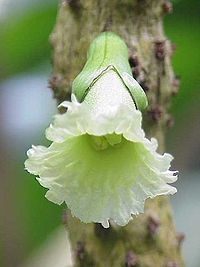
Photo from wikipedia
The complex orogeny of the Himalaya and the Qinghai-Tibet Plateau (QTP) fosters habitat fragmentation that drives morphological differentiation of mountain plant species. Consequently, determining phylogenetic relationships between plant subgenera using… Click to show full abstract
The complex orogeny of the Himalaya and the Qinghai-Tibet Plateau (QTP) fosters habitat fragmentation that drives morphological differentiation of mountain plant species. Consequently, determining phylogenetic relationships between plant subgenera using morphological characters is unreliable. Therefore, we used both molecular phylogeny and historical biogeographic analysis to infer the ancestral states of several vegetative and reproductive characters of the montane genus Incarvillea. We determined the taxonomic position of the genus Incarvillea within its family and inferred the biogeographical origin of taxa through Bayesian inference (BI), maximum likelihood (ML) and maximum parsimony (MP) analyses using three molecular data sets (trnL-trnF sequences, nr ITS sequences, and a data set of combined sequences) derived from 81% of the total species of the genus Incarvillea. Within the genus-level phylogenetic framework, we examined the character evolution of 10 key morphological characters, and inferred the ancestral area and biogeographical history of the genus. Our analyses revealed that the genus Incarvillea is monophyletic and originated in Central Asia during mid-Oligocene ca. 29.42 Ma. The earliest diverging lineages were subsequently split into the Western Himalaya and Sino-Himalaya during the early Miocene ca. 21.12 Ma. These lineages resulted in five re-circumscribed subgenera (Amphicome, Olgaea, Niedzwedzkia, Incarvillea, and Pteroscleris). Moreover, character mapping revealed the ancestral character states of the genus Incarvillea (e.g., suffruticose habit, cylindrical capsule shape, subligneous capsule texture, absence of capsule wing, and loculicidal capsule dehiscence) that are retained at the earliest diverging ancestral nodes across the genus. Our phylogenetic tree of the genus Incarvillea differs from previously proposed phylogenies, thereby recommending the placement of the subgenus Niedzwedzkia close to the subgenus Incarvillea and maintaining two main divergent lineages.
Journal Title: Plant Diversity
Year Published: 2021
Link to full text (if available)
Share on Social Media: Sign Up to like & get
recommendations!